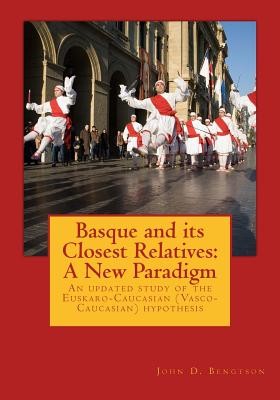
- We will send in 10–14 business days.
- Author: John D Bengtson
- Publisher: CreateSpace Independent Publishing Platform
- Year: 2017
- Pages: 546
- ISBN-10: 154464163X
- ISBN-13: 9781544641638
- Format: 17.8 x 25.4 x 2.8 cm, minkšti viršeliai
- Language: English
- SAVE -10% with code: EXTRA
Reviews
Description
This book is the most comprehensive and detailed treatment of the Euskaro-Caucasian hypothesis, i.e., a proposal that the Basque language is most closely related to the North Caucasian language family. A more or less similar hypothesis was developed in the twentieth century by prominent scholars, including C.C. Uhlenbeck, Georges Dumézil, and René Lafon. The efforts of these savants, and others, while important, were rather sporadic and consisted of scattered articles, and they never developed a comprehensive phonological and morphological model of Euskaro-Caucasian. Their work on the hypothesis ceased with the death of the last of them, Dumézil, in 1986. On the other hand, thanks to advances in our understanding of Basque phonology and etymology (mainly by Luis Michelena [Koldo Mitxelena]), and in North Caucasian phonology and etymology (e.g., by Balkarov, Shagirov, Abdokov, Chirikba, Nikolaev & Starostin), and improved linguistic methods, it has become possible for the author to develop a comprehensive Euskaro-Caucasian phonological structure, including regular sound correspondences of vowels and consonants supported by significant numbers of etymologies. These correspondences, in turn, allowed the author to evaluate objectively the etymological proposals of earlier investigators (which led to the modification or outright rejection of many of them), and also provided clues to discovering some original etymologies. The nucleus of the Euskaro-Caucasian hypothesis is "old," beginning in the nineteenth century, but the "new paradigm" alluded to in the provisional title refers to (a) a focus on the North Caucasian language family as the closest surviving relative of Basque (as opposed to the "South Caucasian" = Kartvelian family), (b) a new and comprehensive scheme of comparative phonology, (c) new discoveries in comparative morphology, and (d) several hundred lexical and grammatical etymologies that supersede the more haphazard comparisons offered in earlier works. "John Bengtson is one of the brilliant linguists of our time." [Igor M. Diakonoff, Oriental Institute, St. Retersburg, Russia. 1999.
EXTRA 10 % discount with code: EXTRA
The promotion ends in 22d.15:11:45
The discount code is valid when purchasing from 10 €. Discounts do not stack.
- Author: John D Bengtson
- Publisher: CreateSpace Independent Publishing Platform
- Year: 2017
- Pages: 546
- ISBN-10: 154464163X
- ISBN-13: 9781544641638
- Format: 17.8 x 25.4 x 2.8 cm, minkšti viršeliai
- Language: English English
This book is the most comprehensive and detailed treatment of the Euskaro-Caucasian hypothesis, i.e., a proposal that the Basque language is most closely related to the North Caucasian language family. A more or less similar hypothesis was developed in the twentieth century by prominent scholars, including C.C. Uhlenbeck, Georges Dumézil, and René Lafon. The efforts of these savants, and others, while important, were rather sporadic and consisted of scattered articles, and they never developed a comprehensive phonological and morphological model of Euskaro-Caucasian. Their work on the hypothesis ceased with the death of the last of them, Dumézil, in 1986. On the other hand, thanks to advances in our understanding of Basque phonology and etymology (mainly by Luis Michelena [Koldo Mitxelena]), and in North Caucasian phonology and etymology (e.g., by Balkarov, Shagirov, Abdokov, Chirikba, Nikolaev & Starostin), and improved linguistic methods, it has become possible for the author to develop a comprehensive Euskaro-Caucasian phonological structure, including regular sound correspondences of vowels and consonants supported by significant numbers of etymologies. These correspondences, in turn, allowed the author to evaluate objectively the etymological proposals of earlier investigators (which led to the modification or outright rejection of many of them), and also provided clues to discovering some original etymologies. The nucleus of the Euskaro-Caucasian hypothesis is "old," beginning in the nineteenth century, but the "new paradigm" alluded to in the provisional title refers to (a) a focus on the North Caucasian language family as the closest surviving relative of Basque (as opposed to the "South Caucasian" = Kartvelian family), (b) a new and comprehensive scheme of comparative phonology, (c) new discoveries in comparative morphology, and (d) several hundred lexical and grammatical etymologies that supersede the more haphazard comparisons offered in earlier works. "John Bengtson is one of the brilliant linguists of our time." [Igor M. Diakonoff, Oriental Institute, St. Retersburg, Russia. 1999.


Reviews